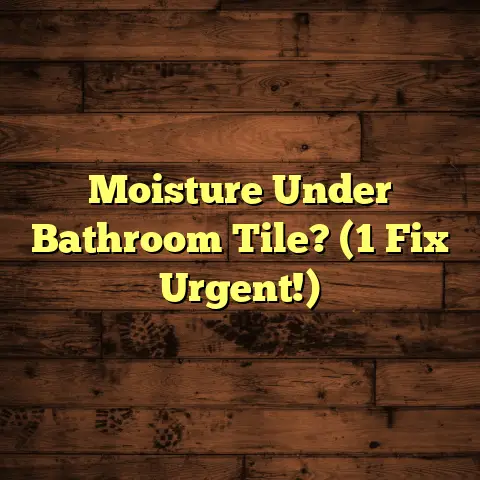Stick-On Marble Tiles: Benefits? (9 Month Curse!)
Now, I know what you’re thinking: “Marble? Stick-on? Is that even a thing?” Trust me, it is, and it’s been making waves in the DIY scene for its promise of affordable elegance.
But is it too good to be true? Let’s peel back the layers (pun intended!) and see what’s what.
These tiles, also known as self-adhesive marble tiles, are designed to mimic the luxurious look of natural marble without the hefty price tag or back-breaking installation.
They’re typically made from a composite material, often a vinyl or PVC base, with a printed marble pattern on top. This is usually protected by a wear layer.
Think of it as a high-tech sticker for your floor or wall! The appeal is obvious: you get the sophisticated aesthetic of marble with a fraction of the cost and effort.
But, as with anything that sounds this good, there are things you need to know. So, stick around (another pun!), and let’s get into it.
Section 1: The Aesthetic Appeal of Stick-On Marble Tiles
Let’s be honest, the main reason most folks consider stick-on marble tiles is for the look. And, I’ll give them credit, they can be pretty convincing.
These tiles instantly elevate a space. They bring a touch of luxury and sophistication that’s hard to achieve with other budget-friendly options.
I’ve seen clients transform drab bathrooms and kitchens into chic, Instagram-worthy spaces simply by using these tiles.
The variety is impressive too. You’re not stuck with just one “marble” design. You’ll find options mimicking Carrara, Calacatta, Statuario, and more.
Plus, they come in a range of colors, from classic white and gray to bolder blacks and even some with metallic accents.
- Carrara: Classic white with soft, feathery gray veining.
- Calacatta: Brighter white with bolder, more dramatic veining.
- Statuario: Similar to Calacatta but with even more pronounced veining.
This versatility means they can fit into almost any design style, from ultra-modern minimalist to traditional and ornate.
Want a sleek, contemporary kitchen? Go for a large-format, high-gloss stick-on marble tile.
Dreaming of a vintage-inspired bathroom? Opt for smaller, more textured tiles with a matte finish.
The possibilities are endless, and that’s a huge part of their appeal.
Section 2: Practical Advantages of Stick-On Marble Tiles
Okay, so they look good. But what about the practical side of things? This is where stick-on marble tiles really shine.
The biggest advantage? The DIY-friendly installation. You don’t need to be a seasoned contractor to install these.
I’ve seen complete beginners achieve impressive results with just a few basic tools and a little patience.
Here’s what you’ll typically need:
- Measuring tape: Essential for accurate cuts.
- Utility knife or scissors: For trimming the tiles to fit.
- Straight edge or ruler: To guide your cuts.
- Pencil: For marking measurements.
- Clean cloth or sponge: To prep the surface.
- Optional: Seam roller: To ensure a strong bond (recommended).
The installation process is usually as follows:
- Prepare the surface: Ensure it’s clean, dry, and level. Remove any debris or old flooring.
- Measure and plan: Determine the layout and make any necessary cuts.
- Peel and stick: Remove the backing and carefully apply the tile to the surface.
- Press firmly: Use your hands or a seam roller to ensure a strong bond.
- Repeat: Continue laying the tiles, ensuring they’re aligned correctly.
Compared to traditional marble, which requires professional installation, mortar, grout, and specialized tools, stick-on tiles are a breeze.
And that ease of installation translates to significant cost savings. You’re not paying for labor, which can be a substantial part of the overall expense.
Speaking of cost, let’s talk numbers. Traditional marble can easily cost $10-$40+ per square foot, plus installation.
Stick-on marble tiles, on the other hand, can range from $1-$5 per square foot, making them a much more budget-friendly option.
Here’s a quick comparison table:
| Feature | Traditional Marble | Stick-On Marble Tiles |
|---|---|---|
| Cost per sq ft | $10 – $40+ | $1 – $5 |
| Installation Cost | $5 – $15+ | $0 (DIY) |
| Installation Difficulty | High | Low |
| Tools Required | Specialized | Basic |
As you can see, the savings can be substantial, especially if you’re tackling a large area.
Section 3: Durability and Maintenance
Now, let’s talk about the elephant in the room: durability. Can a sticker really hold up to the demands of everyday life?
Well, the answer is… it depends. Stick-on marble tiles are not as durable as real marble. Let’s get that straight.
Real marble is a natural stone that can last for centuries with proper care. Stick-on tiles, being made of vinyl or PVC, are more susceptible to wear and tear.
They can scratch, dent, and fade over time, especially in high-traffic areas. However, they’re surprisingly resistant to moisture.
I’ve seen them used successfully in bathrooms and kitchens without any major issues, as long as they’re properly installed and the seams are sealed.
Compared to real marble, which can be porous and stain easily, stick-on tiles are much easier to clean.
A simple wipe with a damp cloth and mild detergent is usually all it takes to keep them looking their best.
Avoid harsh chemicals or abrasive cleaners, as these can damage the surface.
The longevity of the adhesive is another key factor. The quality of the adhesive varies widely between brands and products.
Cheaper tiles often use a low-quality adhesive that can dry out or lose its grip over time, leading to peeling and lifting.
High-quality tiles, on the other hand, use a stronger, more durable adhesive that can last for years.
To maximize the lifespan of your stick-on marble tiles, here are a few tips:
- Choose high-quality tiles: Don’t skimp on price. Invest in tiles with a good reputation and strong adhesive.
- Prepare the surface properly: A clean, dry, and level surface is crucial for a strong bond.
- Use a seam roller: This helps to ensure the tiles are firmly adhered to the surface.
- Seal the seams: This prevents moisture from seeping underneath the tiles and weakening the adhesive.
- Clean regularly: Wipe up spills promptly and avoid harsh chemicals.
- Use mats and rugs: Protect high-traffic areas from wear and tear.
Section 4: The 9-Month Curse
Okay, here’s where things get interesting… and a little spooky. I’ve heard it whispered among DIYers, seen it in online forums, and even experienced it myself: the dreaded “9-Month Curse.”
What is this curse, you ask? It’s the phenomenon where stick-on marble tiles start to fail, peel, lift, or discolor around the 9-month mark after installation.
I know, it sounds like something out of a horror movie, but it’s a real issue that many people have encountered.
The symptoms can vary, but the most common complaints include:
- Peeling and lifting: The edges of the tiles start to peel up, creating unsightly gaps and tripping hazards.
- Discoloration: The tiles start to fade or yellow, especially in areas exposed to sunlight.
- Wear and tear: Scratches, dents, and other signs of wear become more noticeable.
- Adhesive failure: The adhesive simply gives up, causing the tiles to detach from the surface.
So, what causes this “curse”? There are a few factors at play:
- Humidity and temperature changes: Fluctuations in humidity and temperature can cause the tiles to expand and contract, putting stress on the adhesive.
- Poor surface preparation: If the surface wasn’t properly cleaned and leveled, the adhesive may not have a strong enough bond.
- Low-quality adhesive: As mentioned earlier, cheaper tiles often use a low-quality adhesive that’s prone to failure.
- Improper installation: Gaps between the tiles can allow moisture to seep underneath, weakening the adhesive.
Here’s where my personal experience comes in. I once used stick-on marble tiles in a small bathroom renovation for a client on a tight budget.
Everything looked great at first, but about 8 months later, I got a call. The tiles around the shower were peeling up, and there was some discoloration.
I went back to investigate and found that the adhesive had failed in those areas, likely due to the constant exposure to moisture.
I ended up having to replace the tiles with a more water-resistant option. Lesson learned!
To mitigate the “9-Month Curse,” here’s what I recommend:
- Choose high-quality tiles with a strong adhesive. Read reviews and look for products specifically designed for high-moisture areas.
- Prepare the surface meticulously. Clean, dry, and level is the mantra.
- Use a waterproof sealant. Apply a sealant along the edges of the tiles, especially in bathrooms and kitchens.
- Consider using additional adhesive. For extra security, you can apply a thin layer of construction adhesive to the back of the tiles before installation.
- Monitor the tiles regularly. Keep an eye out for any signs of peeling or lifting and address them promptly.
Section 5: Comparison with Other Flooring Options
So, how do stick-on marble tiles stack up against other flooring options? Let’s take a look:
- Traditional Marble: As we’ve discussed, real marble is the gold standard in terms of luxury and durability. But it’s also the most expensive and requires professional installation.
- Vinyl Flooring: Vinyl is a popular budget-friendly option that’s durable, water-resistant, and easy to install. However, it doesn’t have the same high-end look as marble.
- Ceramic Tiles: Ceramic tiles are a versatile and durable option that comes in a wide range of styles and prices. They’re more expensive and difficult to install than stick-on tiles, but they offer better long-term performance.
Here’s a comparison table:
| Feature | Stick-On Marble Tiles | Traditional Marble | Vinyl Flooring | Ceramic Tiles |
|---|---|---|---|---|
| Cost | Low | High | Low to Medium | Medium |
| Installation | Easy | Difficult | Easy | Difficult |
| Durability | Moderate | High | High | High |
| Water Resistance | Good | Moderate | Excellent | Excellent |
| Aesthetic Appeal | High (Marble Look) | High (Authentic) | Moderate | Varies |
One area where stick-on marble tiles really shine is in their flexibility and design versatility.
They can be used on walls, floors, backsplashes, and even furniture. They can be cut and shaped to fit any space, and they come in a wide range of colors, patterns, and finishes.
This makes them a great option for DIY projects and creative home decor.
Section 6: Customer Experiences and Testimonials
Let’s hear from some real people who have used stick-on marble tiles:
Sarah, Homeowner: “I used stick-on marble tiles in my bathroom, and I love the way they look! They completely transformed the space. The installation was easy, and the price was right. However, after about a year, some of the tiles started to peel up around the shower. I’m going to try resealing them and see if that helps.”
Mark, DIY Enthusiast: “I used stick-on marble tiles to create a backsplash in my kitchen. It was a fun and easy project, and the results were amazing. I’ve had them for about six months now, and so far, so good. I made sure to use a good sealant, and I clean them regularly.”
Emily, Renter: “As a renter, I can’t make any permanent changes to my apartment. Stick-on marble tiles were the perfect solution for adding some style to my kitchen. They’re easy to remove when I move out, and they don’t damage the walls.”
These testimonials highlight both the positive and negative aspects of stick-on marble tiles.
People love the look, the ease of installation, and the affordability. But they also acknowledge the potential for issues like peeling and lifting.
Section 7: Future of Stick-On Marble Tiles
What does the future hold for stick-on marble tiles? I think we’ll see continued advancements in materials and adhesive technology.
Manufacturers are constantly working to improve the durability, water resistance, and longevity of these tiles.
We may also see the development of new and innovative designs, such as 3D-printed tiles or tiles with integrated smart features.
One area where I see a lot of potential is in the development of stronger, more durable adhesives.
Imagine a stick-on marble tile that can truly stand the test of time, without any peeling, lifting, or discoloration. That would be a game-changer.
Another area of innovation is in the use of sustainable and eco-friendly materials.
As consumers become more environmentally conscious, there’s a growing demand for flooring options that are both stylish and sustainable.
Stick-on marble tiles made from recycled materials or with low-VOC adhesives could be a big hit in the future.
Conclusion
So, are stick-on marble tiles a beauty on a budget or a 9-month nightmare? The answer, as with most things in life, is… it depends.
They offer a unique combination of aesthetics, practicality, and affordability. They can transform a space quickly and easily, without breaking the bank.
However, they’re not as durable as traditional marble or other flooring options. They’re prone to peeling, lifting, and discoloration, especially in high-moisture areas.
The “9-Month Curse” is a real issue that you need to be aware of.
If you’re considering stick-on marble tiles, do your research, choose high-quality products, and prepare the surface meticulously.
Use a good sealant, monitor the tiles regularly, and be prepared to make repairs if necessary.
With proper care and attention, you can enjoy the beauty of marble without the hefty price tag.
But, if you’re looking for a truly long-lasting and low-maintenance flooring option, you may want to consider other alternatives.
Ultimately, the decision is yours. I hope this article has given you a comprehensive understanding of stick-on marble tiles and the nuances of their use in home flooring.
Happy renovating!





